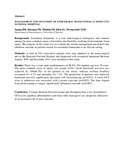| dc.contributor.author | Nganga, HK | |
| dc.contributor.author | Kitunguu, PK | |
| dc.contributor.author | Mbuthia, JM | |
| dc.contributor.author | Kiboi, JG | |
| dc.contributor.author | Mwang’ombe, NJM | |
| dc.date.accessioned | 2013-11-29T15:25:01Z | |
| dc.date.available | 2013-11-29T15:25:01Z | |
| dc.date.issued | 2013-06 | |
| dc.identifier.citation | Nganga HK, Kitunguu PK, Mbuthia JM, Kiboi JG, Mwang’ombe NJM;Management And Outcomes Of Extradural Haematomas At Kenyatta National Hospital,presented at the 2nd International Scientific Conference, Chs And Knh, 19th - 21st June 2013. | en |
| dc.identifier.uri | http://hdl.handle.net/11295/61228 | |
| dc.description | Management And Outcomes Of Extradural Haematomas At Kenyatta National Hospital,presented at the 2nd International Scientific Conference, CHS And KNH, 19th - 21st June 2013. | en |
| dc.description.abstract | Background: Extradural hematoma is a true neurosurgical emergency and
remains among the most common causes of mortality and disability resulting
from traumatic brain injury. The purpose of this study was to evaluate the current
management and factors that influence outcome in patients treated for extradural
hematoma in an African setting.
Methods: A total of 224 consecutive patients who were admitted to the
neurosurgical unit at the Kenyatta National Hospital and diagnosed with
extradural hematoma between January 2007 and December 2011 were included
in this study.
Results: There was a clear male predominance of 96.9%. The median age was
29 years. The most common cause of injury was assault (45%). Good functional
recovery was achieved by 190(86.2%) of the patients in our series, whereas
residual disability accounted for 6.7% and mortality for 7.1%. The proportion
of patients who achieved functional recovery significantly decreased with
increasing age (p=0.011). A lower GCS score at admission was associated with
a poorer outcome (p=0.032). The time elapsed from initial trauma to surgery
significantly influenced outcome (p=0.007).
Conclusion: A longer duration between trauma and decompression, a low
preoperative GCS score, pupillary abnormalities and those older than age 61 are
prognostic indicators of an increased risk of poor outcome. | en |
| dc.language.iso | en | en |
| dc.publisher | University of Nairobi | en |
| dc.title | Management And Outcomes Of Extradural Haematomas At Kenyatta National Hospital | en |
| dc.type | Presentation | en |
| local.publisher | College of Health Sciences | en |

